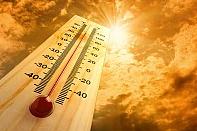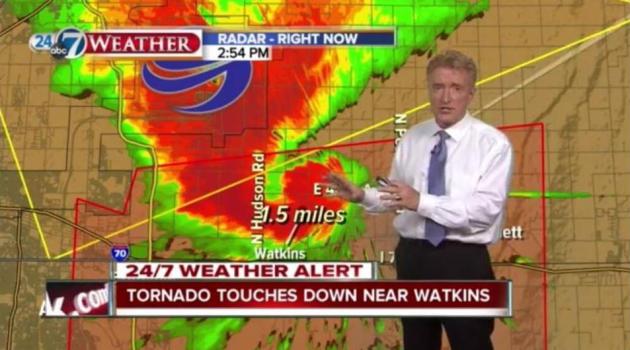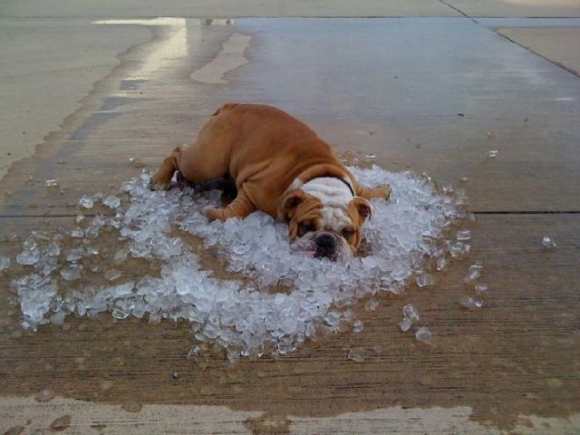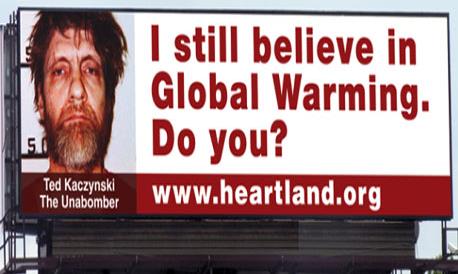77 F. average high on June 9.
84 F. high on June 9, 2016.
June 10, 1926: An intense downpour falls on Mahoning. 3.05 inches fell in 45 minutes.

If Anyone Asks: "Yes, It's Hot Enough For Me"
At least one forecast will verify. Most of us will gripe as we dart from one air-conditioned space to the next. Such tough, first-world problems.
How on Earth did our ancestors keep their cool before 1902, when Willis Carrier invented a contraption that would "condition the air"? A Mental Floss story explains how people coped, when they weren't wading into their favorite lakes. They slept on porches, used ceiling fans, only staying in upper rooms at night. They slept in their basements, which stayed comfortable.
A few tormented souls slept in refrigerated sheets and kept underwear in the freezer. I have to try that, and hope my wife doesn't freak out.
Expect mid-90s today with a heat index near 100F. Heavy T-storms sprout Sunday, keeping us noticeably cooler. I see another surge of 90s Tuesday before midweek T-storms mark the approach of cooler, less humid air.
A heat wave builds across the USA in the coming weeks, but a series of cool puffs from the Canadian Provinces will take the edge off our heat.
A free Minnesota cool front by late June? Frozen undies optional.
Heat Advisory Posted. The combination of heat + humidity will create a heat index close to 100F by mid-afternoon. Take it easy out there. Details from the Twin Cities National Weather Service.
Excessive Heat Predicted for the Coming Week Could Affect Your Medication. Not only the heat, but sunlight can impact the efficacy of certain medications. Dr. Marshall Shepherd explains at Forbes: "...According to information on the Baystate Health organization website, there are standards for storing medications that have been set by the U.S. Pharmacopeial Convention. The guidance on the website
One of the standards established by the U.S. Pharmacopeial Convention is to keep medications stored at room temperature, which is defined as between 68 to 77 degrees F. However, most pharmacists will agree that they are still safe between 58 to 86 degrees F.Medications can also be affected by direct sunlight. Excessive heat or direct sunlight can render some medications less potent. Baystate Health organization experts suggest that medications taken for diabetes and heart disease are particularly vulnerable...Other particularly heat sensitive medications include those used to treat the thyroid and for birth control. Medications with hormones, albuterol inhalers, diazepam, and lorazepam are also listed..."

Dress for Hot Weather Success. Although survival is probably a good place to start. Thanks to HealthTalkUMN at the University of Minnesota.
Avoid a Heat-Related Vehicle Disaster. Keep in mind your vehicle quickly becomes an oven, a hyper-local greenhouse effect during the summer months. According to NOAA studies an outside air temperature of only 80F can translate into 99F after only 10 minutes; 109F within 20 minutes. Don't even think about leaving a child (or pet) in a car or truck.
Photo credit: "Rick Larrick at the Cardinals Hall of Fame in St. Louis."
Starting Hurricane Season Without Leaders of NOAA and FEMA Should "Scare the Hell Out of Everbody". CNN.com has details: "...The two agencies that protect the country's coast lines and its residents, NOAA and the Federal Emergency Management Agency (FEMA) are still without leaders -- positions that must be appointed by President Donald Trump and confirmed by the Senate. "That should scare the hell out of everybody," retired US Lt. Gen. Russel Honoré told CNN. "These positions help save lives." Honoré knows all too well the value that leadership plays during a crisis, as he commanded Joint Task Force Katrina. He coordinated military relief efforts in the aftermath of Hurricane Katrina. Lt. Gen. Russel L. Honoré talks to his soldiers at Camp Shelby, Mississippi, on September 8, 2005. Despite concerns, FEMA and NOAA say they are prepared for the hurricane season and the aftermath of any storms that make landfall and cause damage..." (File image of Hurricane Dennis: NASA).
2016 State of U.S. High Tide Flooding. With slowly rising seas many cities no longer require a major storm for storm surge flooding as reported by NOAA NCDC: "...This month's State of the Climate report includes an annual update of the state of coastal high tide flooding. Sometimes called nuisance or sunny day flooding, this type of flooding occurs when water levels measured at a NOAA tide gauges exceed locally established heights associated with minor impacts, such as water on low-lying streets or infiltration into storm-water systems. Such coastal flooding is increasing in frequency, depth and extent in many areas of the U.S. due to on-going increases in local relative sea level. Decades ago, coastal flooding mostly occurred during strong storms. Today, it occurs more frequently during high-tide cycles and calmer weather. Though high tide flooding today is rarely life threatening, it is a serious concern in several communities, such as Norfolk, Virginia, Charleston, South Carolina and Miami, that are not protected by flood control structures that cities like New Orleans have in place.
- Several cities experienced more than a month (30 days) of daily flooding in 2016: Wilmington, NC (84 days); Charleston, SC (50 days); Honolulu, HI (45 days); Annapolis, MD (42 days); Savannah, GA (38 days); Washington D.C. (33 days); and Port Isabel, TX (31 days) due to a combination of low-lying coastal topography and high sea levels during 2016..."
U.S. Coastal Cities Will Flood More Often and More Severely, Study Warns. More perspective at InsideClimate News: "...Oppenheimer says he's most concerned about chronic, but less-extreme flooding along the East Coast, including the south shore of New York's Long Island, the low country around Charleston, S.C., and south Florida, where tidal flooding already has become an everyday occurrence. "These areas have terrain that's gently sloped," Oppenheimer said. "South Florida is really in trouble. Not only are they having a lot of nuisance flooding, but they sit on limestone, which makes it extremely difficult to build coastal defenses. These places really have to get on the ball and decide what they have to protect." But adapting for the risk takes time, political will and money..."
Map credit: Nature Climate Change.

Report: National Weather Service Meteorologists "Fatigued" and "Demoralized" by Understaffing. Just in case you missed this from Angela Fritz at Capital Weather Gang: "The employees of the National Weather Service are demoralized, according to a recent report by the Government Accountability Office. They are understaffed and spread thin, covering shifts and positions beyond what they were hired to fill. The weather never sleeps, and apparently neither does the Weather Service. Between 2014 and 2016, the number of vacant staff meteorologist positions increased 57 percent. In the same time, management vacancies decreased by 29 percent. The mission of the Weather Service — to protect lives and property — is critical, so the employees are completing the tasks. But it comes at a cost. The GAO used some pretty gloomy language to describe the employees’ current state of mind..."
Florida Tech Study Confirms Lightning More Powerful Over Water. Here's a clip of another article that caught my eye, courtesy of Florida Tech: "...Nag and Cummins found that with strikes over water in western Florida, the median stepped-leader duration was 17 percent shorter over ocean than over land, and in eastern Florida the median durations were 21 and 39 percent shorter over two oceanic regions than over land. Using a relationship between leader duration and lightning peak current derived in this study, the authors estimate that lightning with peak currents over 50 kilo amperes is twice as likely to occur in oceanic thunderstorms. These findings suggest that people living on or near the ocean may be at greater risk for lightning damage if storms develop over oceans and move on-shore. This new understanding of the nature of lightning could inform how off-shore infrastructure and vessels are to be built to minimize the risk of super-powerful lightning bolts from thunderstorms formed over the sea..."
Intense Storms May Diminish Protective Ozone in Central U.S. Are super-sized thunderstorms doing more than increasing flash flood risk? Here's a clip from Daily Climate: "More frequent, powerful storms in the Great Plains are penetrating deep into the atmosphere, risking ozone loss and increased dangerous UV radiation, scientists warn...Harvard researchers found that this stratospheric ozone layer above the central U.S. gets depleted during the summer, most likely as intense storms send water vapor into the atmosphere. The vapor can cause the types of chemical reactions that have spurred ozone loss in Arctic and Antarctic regions. The stratosphere, which extends from about 7 miles above the surface to nearly 30 miles above the ground, is one of the most “delicate aspects of habitability on the planet,” the researchers wrote in the study published in the Proceedings of the National Academy of Sciences this week. The Great Plains' more frequent and violent storms get that extra energy in large part from warming waters in the Gulf of Mexico. The Harvard study shows that, in addition to storm damage, the loss of ozone threatens food security and human health..."
Photo credit: Kelly DeLay/flickr
"Coal is Dead" and Oil Faces "Peak Demand", Says World's Largest Investment Group. ThinkProgress has the story: "Coal is dead,” Jim Barry, the global head of BlackRock’s infrastructure investment group, explained in a recent interview. BlackRock, the world’s largest investment group, with $5 trillion in assets — more than the world’s largest banks — has
begun to bet on clean energy. Why? “The thing that has changed
fundamentally the whole picture is that renewables have gotten so
cheap,” said Barry. No, the world’s coal plants are not going to all
down shut tomorrow, Barry noted to The Australian Financial Review (subscription required). “But anyone who’s looking to take beyond a 10-year view on coal is gambling very significantly...”
Graphic: U.S. Energy Information Administration.
Minnesota Moving Up in Rankings for Solar Energy. Star Tribune reports: "Minnesota’s
national ranking for solar energy capacity has climbed significantly
after a flurry of new projects have come online. During the first
quarter, the state ranked fourth nationally for new solar power
installations compared with the same period a year ago, according to
data released Thursday by the Solar Energy Industries Association
(SEIA), a trade group. The state added 140 megawatts of solar power
capacity in the quarter, continuing a growth spurt that started in last
year’s fourth quarter and reflects long-planned developments being
switched on..."
Photo credit: "Minnesota has added 140 megawatts of solar power capacity during the first quarter of 2017." (AARON LAVINSKY/Star Tribune file photo).
Boeing Is Studying Pilotless Jets. Say what? Speaking of job disruption. Here's an excerpt of an artlce at Fortune that made me do a double-take: "Boeing
is looking ahead to a brave new world where jetliners fly without
pilots and aims to test some of the technology next year, the world's biggest plane maker
said in a briefing ahead of the Paris Airshow. The idea may seem
far-fetched but with self-flying drones available for less than $1,000,
"the basic building blocks of the technology clearly are available,"
said Mike Sinnett, Boeing's vice president of product development.
Jetliners can already take off, cruise and land using their onboard
flight computers and the number of pilots on a standard passenger plane
has dropped to two from three over the years..."
Even Tesla's Elon Musk Makes Mistakes. Here's a clip from an article at Fortune: "...The CEO said he made the decision to significantly pare down the configurations for the Model 3—Tesla's most affordable vehicle yet, starting at $35,000—after learning from mistakes he made with Tesla's SUV known as the Model X, which Musk called "hubris extraordinaire." "The big mistake we made with the X, which primarily was my responsibility, was having way too much complexity right at the beginning. That was very foolish," Musk said. "It had way too many cool things in it that really should have been rolled in with version 2, version 3," he continued. "We got overconfident and created something great that probably will never be made again, and perhaps should not be..."
Fortune 500 CEOs Still Optimistic About the Future. The greatest concern? The pace of technological disruption and AI, artificial intelligence. Here's an excerpt of a post at Fortune: "...Only a few chief executives see the global economy turning worse next year. More than one-third anticipate that it will improve, and over half are expecting things to be about the same. The good news for workers? A strong majority of CEOs say they expect to boost hiring over the next couple of years. As for the Trump effect: not much so far..."
Tornado Hits House As Kids Make First Video. Dan Mitchinson at NewsRadio KFBK in Sacramento posted this video clip; not exactly sure where this took place - but what are the odds? "Kids are making their first YouTube video and tornado hits house that tears off roof and deck during the video. No siren went off and it came on all the sudden with no notice. Everyone in house was safe but entire house has to be demolished and reconstructed..."

TODAY: Sunny, windy and hot. Heat Index near 100F. Winds: SW 15-30. High: 96
SATURDAY NIGHT: Sultry and very warm, isolated T-storm. Low: 70
SUNDAY: Sticky, not as hot. Few T-storms likely. Winds: E 7-12. High: 85
MONDAY: Humid, unsettled. Risk of a storm or two. Winds: E 7-12. Wake-up: 67. High: 87
TUESDAY: Another hot front. Windy. Late storm? Winds: S 15-30. Wake-up: 71. High: 92
WEDNESDAY: T-storms give way to some partial clearing. Winds: SW 10-20. Wake-up: 72. High: 86
THURSDAY: Sunny and pleasant. Less humid. Winds: W 10-15. Wake-up: 65. High: 83
FRIDAY: Few T-storms possible early? Then better. Breathing easier. Winds: NW 10-20. Wake-up: 62. High: 81
Climate Stories...
Dayton Signs Into States' Climate Goal Alliance. Rochester's Post Bulletin has details: "Minnesota's governor is committing the state to upholding the Paris climate change accord by joining an alliance set up by other states with the same goal. Gov. Mark Dayton says he signed onto the U.S. Climate Alliance which was formed after President Donald Trump announced last week that the U.S. would withdraw from the Paris climate change agreement reached by 195 countries last year. California, New York and Washington started the alliance. Minnesota, Puerto Rico and eight other states signed on Monday. Alliance members pledge to reduce emissions 26 to 28 percent from 2005 levels..."
File photo: U.S. Chamber of Commerce Foundation.
Map credit: "States joining the US Climate Alliance shown in green." Illustration: Dana Nuccitelli.
Photo credit: CMU, Thomas Harper.

American's "Under Siege" From Climate Disinformation - Former NASA Chief Scientist. No kidding. Here's a clip from The Guardian: "Americans are “under siege” from disinformation designed to confuse the public about the threat of climate change, Nasa’s former chief scientist has said. Speaking to the Guardian, Ellen Stofan, who left the US space agency in December, said that a constant barrage of half-truths had left many Americans oblivious to the potentially dire consequences of continued carbon emissions, despite the science being unequivocal. “We are under siege by fake information that’s being put forward by people who have a profit motive,” she said, citing oil and coal companies as culprits. “Fake news is so harmful because once people take on a concept it’s very hard to dislodge it...”
Why Conservatives Have Always Distrusted Science. Not all conservatives. And there's a place for both, faith in absolutes and the scientific method; they are not mutually exclusive. Here's an excerpt from Bloomberg View: "...If "technology becomes the god by which we live," warned the National Review columnist Frank Meyer, then the Communists would win, because their system pursued "to its logical conclusion the positivistic glorification of control and power as the end of man’s existence." To go down that route was to worship the false god of "scientism," the philosopher Eric Voegelin wrote, and to make mathematics and physics "substitute for the religious order of the soul." After all, it was the scientific method, what Friedrich Hayek called the "religion of the engineers," that had created the gas chambers in Nazi Germany and the planned economy and labor camps in Stalin’s Russia..."
File image: Catholic World Report.

Photo credit: "In Tuvalu, $36 million will fund protection of the coastline after a 2015 cyclone displaced half the population." Photographer: Sokhin/UNICEF/Zuma Press.
Map credit: "Temperature difference from normal over Lower 48, January to April 2017." (NOAA).
Photo credit: "Journalist Chris Clayton writes for an audience filled with climate skeptics: farmers and leaders of agricultural businesses. He's telling them that a changing climate will disrupt their lives." Courtesy of Chris Clayton.

Graphic credit: Lazaro Gamio / Axios.
Photo credit: Randal Ford.
No comments:
Post a Comment